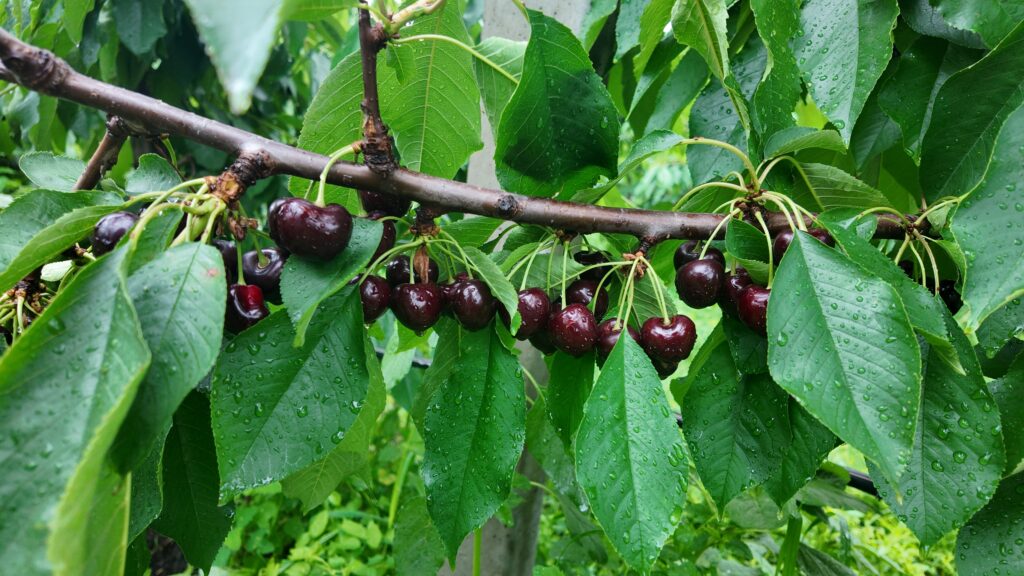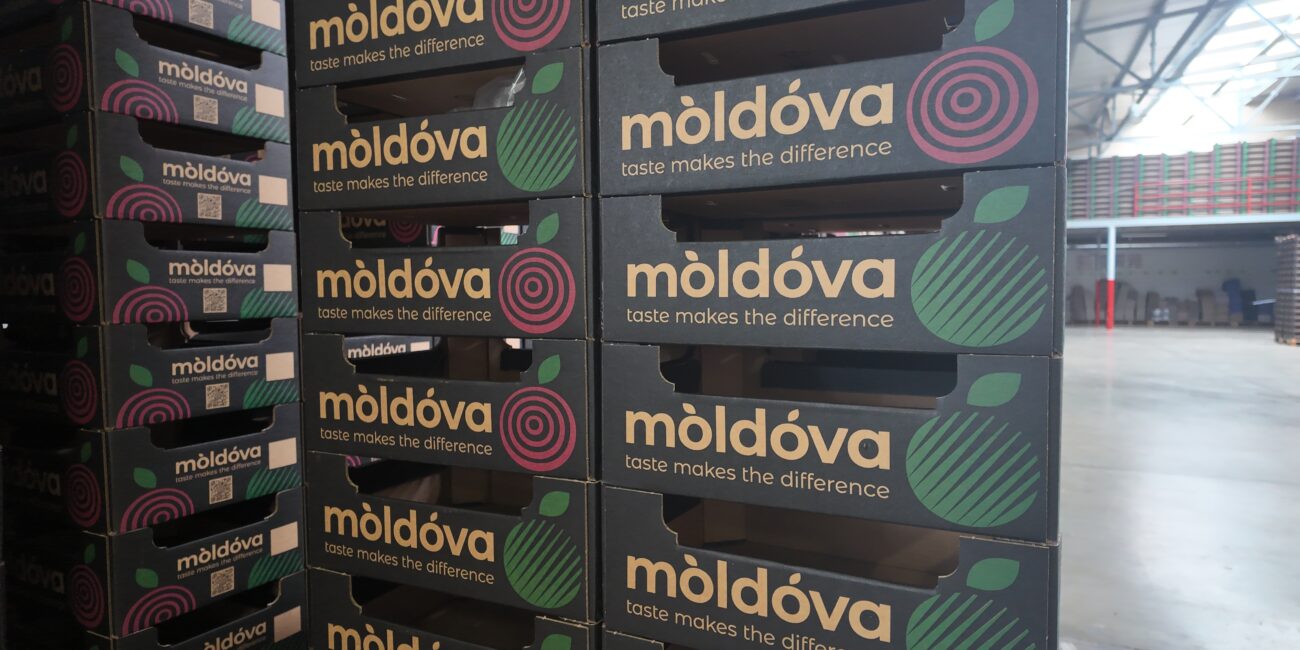War Sends Fruits in the Opposite Direction
Consumers in the European Union are increasingly noticing Moldova on their fruit labels, as Moldova is becoming one of the key exporters in the region.

This summer, a heat wave has been striking Moldova—a small country on the southeastern border of the European Union—where the view from an airplane looks patchy like a knitted blanket due to the fields. Agriculture is an important source of livelihood here. Almost everyone has been complaining about the unpredictable weather.
“300 millimeters of rain in six months, not counting snow! Two years ago, we had 250 millimeters in a year,” says fruit producer Ion Tulei, worried.
He shows us his cherry orchard in southern Moldova, near the Ukrainian border, only 80 kilometers from Odessa. His company Farmprod cultivates 50 hectares of apples, 28 hectares of cherries, and 27 hectares of plums, along with peaches, table grapes, and apricots.
We meet him in the middle of the summer, peak time for cherry picking. “A perfectly ripe cherry is black and firm!” he proudly describes the plants grown in his orchard from seed. Many of his cherries will end up in Germany’s supermarkets.
But there are rows of perfectly sweet cherries on the trees that will just be left to rot. “Heavy rain came and ruined them. They have cracks on them now, and people don’t want them,” he explains. “They eat with their eyes; they want perfection. I am not even bothering to pick them,” Tulei says. That’s around 80 tons of cherries. What a waste.

Despite the weather becoming more unpredictable, Tulei feels that more and more markets are opening up to his produce. “It was pretty easy last year because Europe didn’t have enough cherries, so we were really, really in demand. Everybody was coming to Moldova: ‘I need cherries, I need cherries!’”
This year, his fruit company is already more familiar to EU buyers, who have returned. Just a couple of years ago, most of his cherries were sold to Russia.
The Moldovan Fruit Association says that last year, Moldova exported 2,600 tons of sweet cherries to the European Union. “It’s a huge amount! 12.5 times more than the year before,” says Iurie Fala, executive director of Moldova Fruct. It was the entry point for Moldovan sweet cherries into the EU market.
In 2018, Moldova exported nearly 70 percent of its apricots, cherries, peaches, and plums to Russia. By 2023, only about 18 percent of those fruits ended up in Russia.
Cutting Russian ties
For a long time, Russia was the number one export destination for Moldovan fruits. But bans to pressure the small country into being more pro-Russian have forced it to look for other partners. After the large-scale war in Ukraine, exporting to Russia has started to shrink extremely fast, says Iurie Fala.
“We exported to Russia for many, many years. Our producers had established their practices based on the Russian market,” Fala explains. The shift from Russia to the EU and other parts of the world has been significant.
In 2014, when Moldova signed the association agreement with the European Union, Russia imposed embargo to Moldovan fruits, stating that Moldovan products needed to be controlled more for safety. “It’s just to pressurize the country; there are no actual reasons behind that,” Fala says. For example, at the same time, Moldova’s pro-Russian region, Transnistria, didn’t face similar accusations.
Since many turning points, Moldovan fruit exporters have been wary and are looking for more stable markets.
For example, 80 percent of plums are no longer going to Russia as they traditionally did. Instead, Moldova has become one of the biggest plum exporters to the European Union.
In 2023, Moldova exported nearly 74,000 tons of fresh plums, worth over $38 million, according to Cristina Ceban, State Secretary of the Ministry of Economic Development and Digitalization of Moldova.
Exports to the EU surged 2.6 times compared to 2022, with 60,443 tons, making Moldova the EU’s largest plum exporter, surpassing countries like Spain, South Africa, the Netherlands, and Italy.
Stefan Bitlan, manager of the fruit export company Fani LTD, is one of the plum exporters who says the shift has been a long process for them.
“In February 2022, when the (largescale) war started, we had already closed the seventh season of working exclusively with the European Union, exporting fruit to Romania, Austria, Germany, Latvia, and Poland,” he says.

Today, Fani LTD isn’t exporting to Russia anymore. “You cannot make long-term plans when you don’t have stability,” he explains.
Ion Tulei feels that plums are the easiest to find markets for elsewhere because there is great demand in the European market. His first trucks of plums made it to Germany in 2017. “In 2018, I already exported around 20 trucks,” he says about Moldovan plums.
While cherries are one of the hardest fruits to export because they are expensive and don’t stay fresh for long.
Moldovan apples still need to conquer the European market. Tons of them are still being exported from Moldova to Russia, despite the longer transport route through the Baltic countries instead of Ukraine.
Tulei is also still exporting apples to Russia, with about 30% of his apple production going there. A couple of years ago, the majority was exported to the Russian market. He is now looking for opportunities to sell his apples more to the Middle East. “Any market for us is a good market; we’re happy to have it. But we are not focusing on the Russian market as we used to in the whole of Moldova. I am taking it as a secondary backup market,” he describes. “You wouldn’t want to throw away your fruits if there is somebody who wants to buy them.”
Export to Russia will always be
“The shift is hard because our neighbors are big apple producers and the European Union is itself a great producer,” says Iurie Fala from Moldova Fruct.
In 2018, almost all Moldovan apples ended up in Russia. By 2023, it had dropped to half.
“Because of the fact that the Transnistria region the amount exported to Russia can never be zero,” Iurie Fala thinks.


Moldovans have invested heavily in post-harvesting handling so they can sell their fruits to European markets when the local season is over.
“Moldova should do a lot of marketing in Europe so that this part of the world knows Moldova as a country that produces tasty and quality fruits,” says Stefan Bitlan.
Recently, this is happening more. “This is moving really fast,” Ion Tulei adds. “Moldova Fruct is doing a lot of expos and similar events recently,” he says.
“In 2013, we participated in only one international exhibition in Moscow in a year. Now we are attending seven international trade fairs related to the fruit business, like Fruit Logistica in Berlin and Fruit Attraction in Madrid, putting Moldovan fruit on the world map,” says Iurie Fala.
In 2014, overall exports from Moldova to the Russian Federation accounted for 18% of the country’s total exports. By 2023, this share had shrunk to just 3.6%—a dramatic decline over nearly a decade. The year 2023 marked a significant downturn, with exports to Russia hitting a 26-year low.
Moldova's Trade Evolution: A Shift from Russian Markets to the EU

In 1997, Moldova’s economy was heavily reliant on exports to Russia, with over half of its exports directed to the Russian Federation. However, this dependency became a vulnerability as Moldova’s exports faced a sharp decline in the late 1990s, partially due to economic turmoil in Russia. By 1999, exports had plummeted to just $191.5 million, marking the beginning of a tumultuous period for Moldova’s trade.
The early 2000s saw a modest recovery in exports to Russia, but this was disrupted by the Russian embargo on Moldovan wines in 2006, which caused a significant drop in trade. Despite some fluctuations, by 2012, Moldova’s exports to Russia had reached their peak since 1997, amounting to $655.1 million. However, this success was short-lived.
Following the 2014 signing of the Association Agreement between Moldova and the European Union, Russia imposed a series of sanctions on Moldovan goods, leading to a sharp decline in exports to Russia. By 2018, exports had decreased to $218.6 million, a trend that continued as Moldova increasingly shifted its focus to the EU market. The war in Ukraine in 2022 further accelerated this shift, prompting Moldova to seek greater alignment with Western markets.
The most notable change occurred in the agricultural sector, where Moldovan fruit exports were redirected from Russia to the EU. Between 2018 and 2023, the share of Moldovan fruits exported to Russia drastically decreased, while exports to the EU surged. For instance, the export of plums to the EU increased 2.6 times in 2023, making Moldova the largest exporter of plums to the EU.
The reorientation of Moldova’s exports from East to West was driven by several factors, including the EU’s stable political and economic environment, trade preferences under the Association Agreement, and the frequent imposition of trade restrictions by Russia. As a result, Moldova has significantly reduced its dependency on the Russian market, finding more stable and lucrative opportunities in the European Union. This shift not only reflects Moldova’s economic adaptation but also its strategic alignment with the West in response to geopolitical challenges.

Leave a Reply